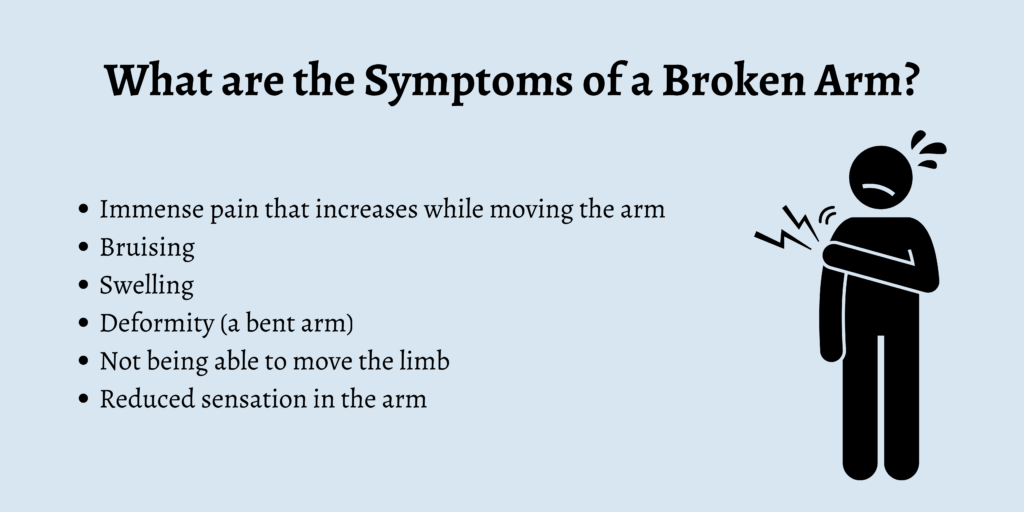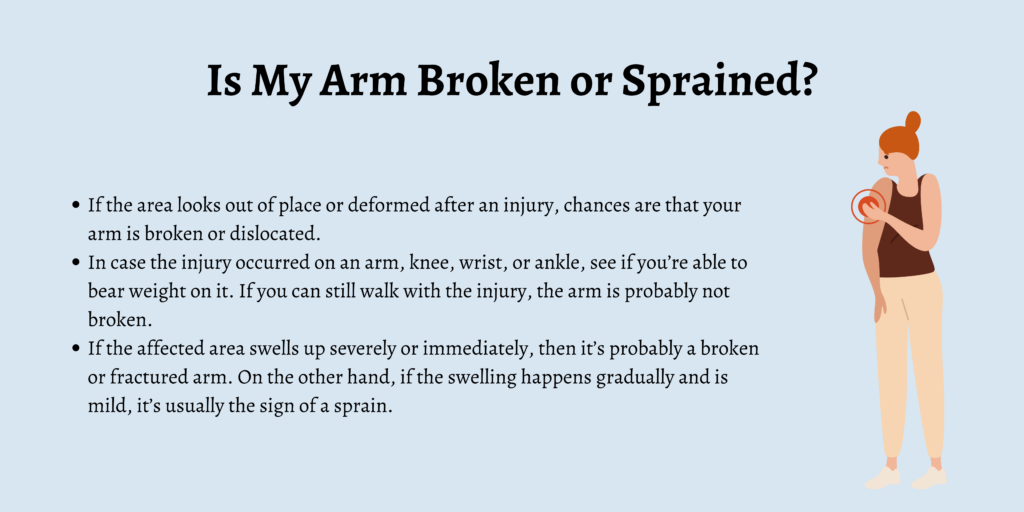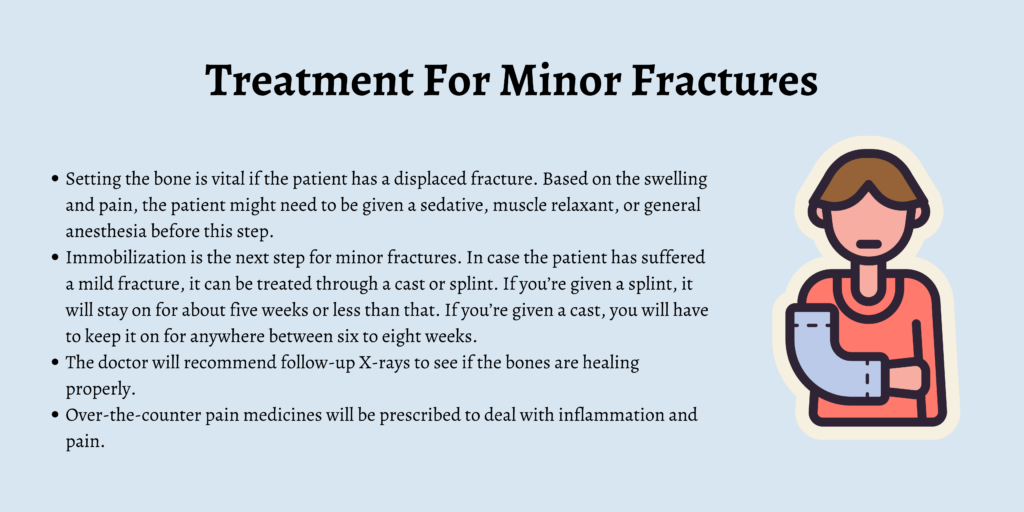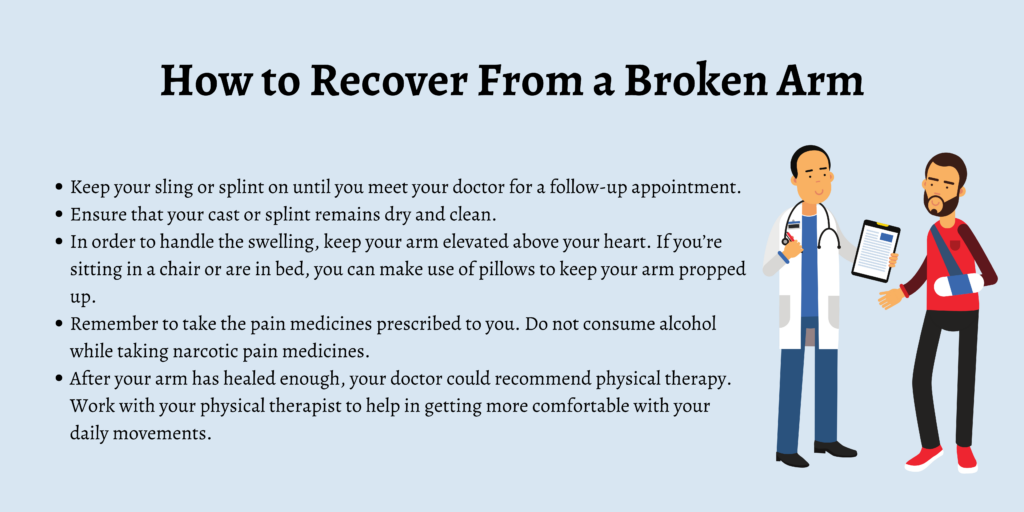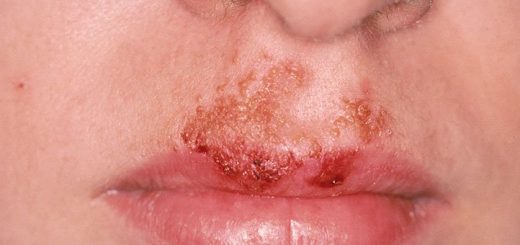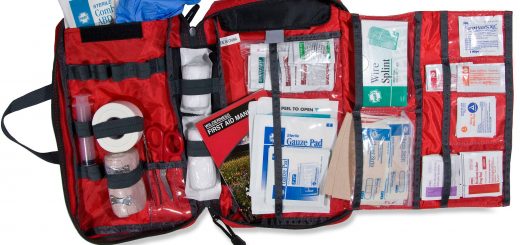First Aid For a Broken Arm
A broken arm entails that one or more than one of the bones in a person’s arm have been cracked due to an injury, which is a common incident among both adults as well as children.
The arm is made up of three bones:
- Humerus (the bone in the upper arm)
- The ulna and the radius (the two bones in the forearm)
There can be many reasons or causes behind a broken arm:
- Falls: A broken arm is most commonly caused by falling onto an outstretched hand or elbow.
- Trauma: When the bones in your arm get broken due to an accident or any other kind of direct trauma.
- Sports injury: Many types of arm fractures occur due to a person experiencing injuries or direct blows while playing any sport.
In this article, we will be elaborating on the symptoms of a broken arm, how to distinguish it from a sprain, and the methods of treatment involved in treating a broken arm.
What Are The Symptoms of a Broken Arm?
The following are some of the symptoms of a broken arm:
- Immense pain that increases while moving the arm
- Bruising
- Swelling
- Deformity (a bent arm)
- Not being able to move the limb
- Reduced sensation in the arm
Types of Fractures
There are various types of fractures. Some of them are as follows:
- Simple or closed fracture: A simple fracture is when the patient’s skin hasn’t been pierced by the broken bone.
- Compound or open fracture: A compound fracture is when the broken bone is visible through the skin.
- Hairline fracture: This is one of the most common types of fractures. It occurs either in the lower leg or foot due to repeated stress as a result of activities such as running or jogging.
- Greenstick fracture: When a patient’s bone gets a small crack. This is usually seen in children.
- Avulsion fracture: This type of fracture occurs when a part of the bone separates from the patient’s main tendon.
- Complicated fracture: A complicated fracture is when there is an injury to the structures surrounding the patient’s fractured area.
- Compression fracture: If two bones within a person’s body are forced against one another, it leads to a compression fracture.
Is My Arm Broken or Sprained?
Fractures and sprains often have a lot of similar symptoms, which is why it can be difficult to tell the difference without consulting a medical professional. However, there are certain signs to look for that can tell you whether your arm is broken or sprained:
- If the area looks out of place or deformed after an injury, chances are that your arm is broken or dislocated.
- In case the injury occurred on an arm, knee, wrist, or ankle, see if you’re able to bear weight on it. If you can still walk with the injury, the arm is probably not broken.
- If the affected area swells up severely or immediately, then it’s probably a broken or fractured arm. On the other hand, if the swelling happens gradually and is mild, it’s usually the sign of a sprain.
What to Do With a Broken Arm or Wrist?
If your arm gets broken, take the steps listed below when you’re at home:
- The first thing you need to do is stabilize your arm. Do this by making a sling using a towel.
- The sling needs to be placed under the arm of the patient and then around the neck.
- In order to control the swelling and pain, apply ice to the injured region.
- Keep the ice on the broken arm for about 20 to 30 minutes, with a couple of intervals in between. Don’t put the ice directly on the patient’s skin. Instead, keep a towel between the skin and the ice pack.
If you have a broken wrist, do the following to ensure recovery:
- Keep your wrist elevated above the heart level for the first couple of days, as this will aid in reducing the swelling or pain.
- Ice your wrist after every two to three hours for about 20 minutes.
- Take over-the-counter pain medications.
- Consult your doctor regarding the stretching exercises you can do to ease the pain and strengthen the area again.
Treatment For a Broken Arm
- Ask the patient to sit down. You will need to immobilize the arm and shoulder by placing the arm in a sling.
- Place the arm in a comfortable position across the chest and ask the patient to support it.
- Use a triangular bandage as an arm sling. Place some soft padding – such as clothing or a folded towel – between the injured arm and the bandage where it lies against the chest. Tie the sling in position to support the arm.
- Tie a broad bandage over the sling and around the chest to secure the sling in place, avoiding the injured area if possible.
- Take or send the patient to hospital or urgent care center in a sitting position.
Treatment For Minor Fractures
When you go to a doctor with a minor fracture, they will first ensure that the affected area stops bleeding. As far as bone fractures are concerned, they will then do the following:
- Setting the bone is vital if the patient has a displaced fracture. Based on the swelling and pain, the patient might need to be given a sedative, muscle relaxant, or general anesthesia before this step.
- Immobilization is the next step for minor fractures. In case the patient has suffered a mild fracture, it can be treated through a cast or splint. If you’re given a splint, it will stay on for about five weeks or less than that. If you’re given a cast, you will have to keep it on for anywhere between six to eight weeks.
- The doctor will recommend follow-up X-rays to see if the bones are healing properly.
- Over-the-counter pain medicines will be prescribed to deal with inflammation and pain.
Treatment For Major Fractures
Major fractures require surgery, and the kind of surgery a doctor opts for depends on the type of fracture the patient has experienced. Some of the different surgeries that fall under this category include:
Internal Fixation
Internal fixation usually requires the presence of rods, pins, wires, plates, and screws. In order to ensure that the fractured bone stays in place, the doctor inserts metal pieces into the patient’s bone. After this procedure, the patient is required to limit the usage of the broken arm so that it heals quickly.
External Fixation
Metal screws and pins are used in external fixation which are placed on either side of the fracture within the patient’s body and into their bone. The screws will be connected through a metal bar outside their skin, and the bones will be held together by pins. This procedure is recommended when the skin around the patient’s broken arm is severely damaged.
Arthroplasty
Arthroplasty is a joint replacement method that is used when a person fractures a joint, such as their knee, elbow, or shoulder. The surgeon will first remove the damaged joint and then be replaced by an artificial joint.
How to Make an Arm Sling
Follow these steps to make an arm sling using a triangular bandage.
- Ask the patient to support the injured arm at the elbow, with the hand slightly above the horizontal position.
- Drape a triangular bandage under the arm, with its long side down the unaffected side of the body, the top round the neck and the point level with the elbow on the affected side.
- Fold the lower end of the bandage up over the forearm and tie it securely over the shoulder with the knot resting in the hollow above the collarbone (clavicle).
- Fold the point of the bandage forwards over the elbow, tuck in and fasten with a safety pin or medical tape.
How to Recover From a Broken Arm
Most cases of broken arms do not require the patient to be admitted to the hospital. Your doctor will suggest you tips to follow to promote recovery. Here is what you should remember while trying to recover from a broken arm:
- Keep your sling or splint on until you meet your doctor for a follow-up appointment.
- Ensure that your cast or splint remains dry and clean.
- In order to handle the swelling, keep your arm elevated above your heart. If you’re sitting in a chair or are in bed, you can make use of pillows to keep your arm propped up.
- Remember to take the pain medicines prescribed to you. Do not consume alcohol while taking narcotic pain medicines.
- After your arm has healed enough, your doctor could recommend physical therapy. Work with your physical therapist to help in getting more comfortable with your daily movements.
- If you feel that the pain in your arm is increasing, if your hands or fingers are turning blue or cold, or if you’re experiencing a loss of sensation, call your doctor immediately.
FAQs
1. What is a broken arm?
A broken arm is when one or more bones in a person’s arm get cracked.
2. What causes a broken arm?
A broken arm can be caused due to accidents, falls, or sports injuries.
3. What are the symptoms of a broken arm?
The symptoms of a broken arm include swelling, immense pain, deformity, and bruising.
4. How can you prevent a broken arm?
A broken arm can be prevented by improving bone strength, wearing proper shoes, and making use of the right kind of protective gear.
5. When should you seek medical care for a broken arm?
You should seek medical care for a broken arm when there is severe pain that can’t be cured through medicines, when there is swelling or deformity, or when one part of the arm hurts from being pressed.
Conclusion
Once you go through an accident, here are the signs that point out that you should seek medical attention:
- There is severe pain in your arm that isn’t going away by using normal medications or through the application of ice packs.
- Use, or even limited use of the injured arm, is causing a lot of pain.
- There is a deformity or swelling visible on the injured arm.
- You experience pain in a specific part of the arm when it’s pressed.
Most of the arm fractures heal eventually, allowing the patient to move their arm in a normal manner. There are numerous factors that affect the outcome of a broken arm:
- The presence of chronic diseases could slow down the healing process, such as diabetes or osteoporosis.
- The results can be better if the injury is treated soon.
- There is a higher chance of experiencing movement issues among older people.
- Children and adolescents tend to heal quicker from fractures and broken arms.
- There could be complications involved with regard to healing when the fracture involves joints, multiple broken bones, infections, or open wounds.
The healing time for a broken arm depends on the severity of the injury and the method of treatment. Make sure to follow the guidelines mentioned by your doctor for a successful recovery.

